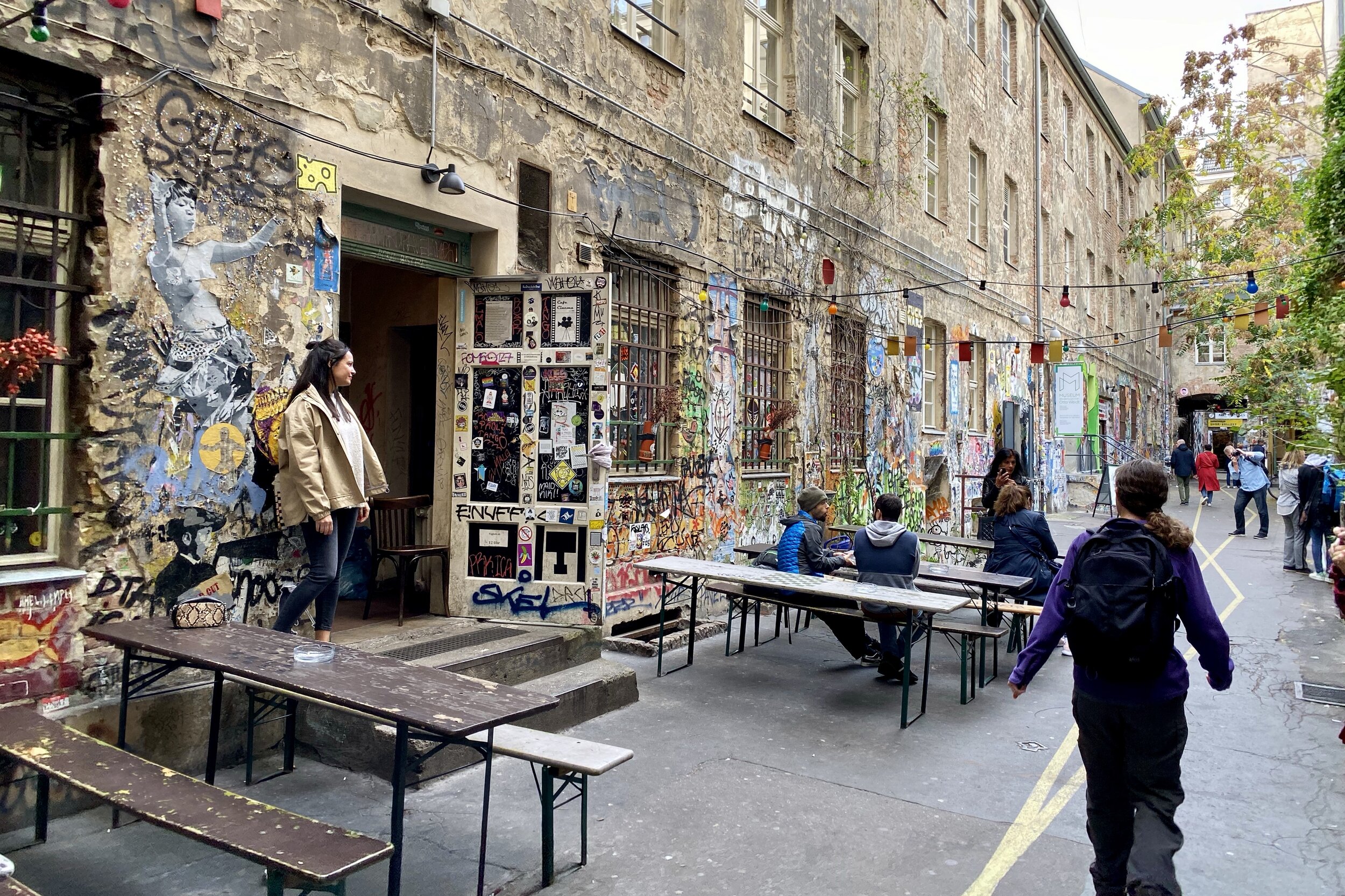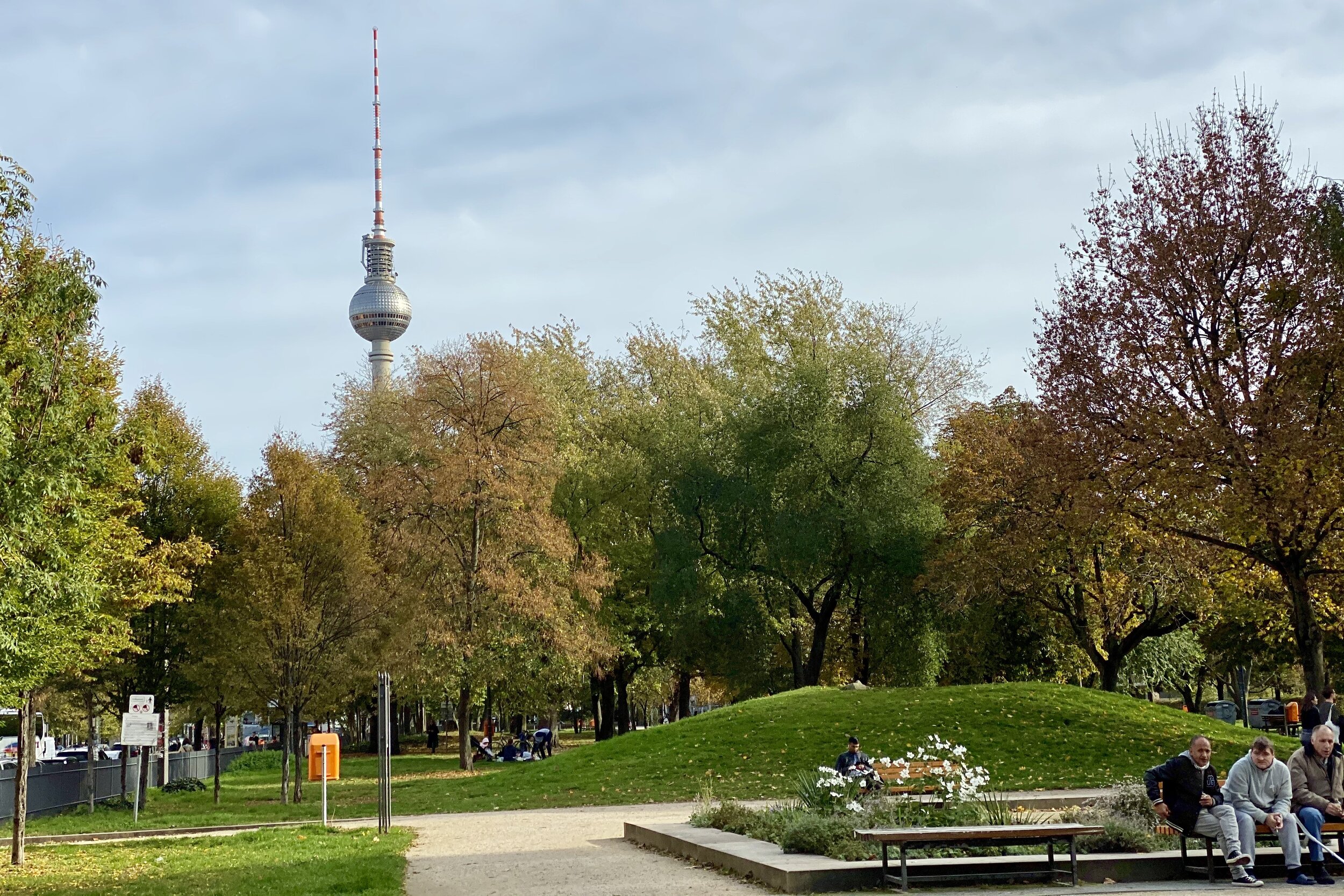Berlin, 26 Oct 2019
For our second full day in Berlin, we went to the Berlin Wall Memorial, then walked through the Old Jewish Quarter.
Having gotten breakfast from the store, we were able to eat a bit earlier than the provided breakfast started. That worked out well since our first destination opened at 9am.
Berlin Wall Memorial
We took a streetcar a bit west from where we're staying, walking past another ghost S-Bahn station, Nordbahnhof. We went to the Visitors Center fo the Berlin Wall Memorial, where we picked up a couple maps and watched a couple videos. The center has two movies that they show, one after the other, in German, then they repeat in English. We walked into a full theater for the tail end of the first movie in German, but there were English subtitles, so I was able to easily follow along. The next movie started, a CGI representation of the wall. That one didn't have English subtitles, but I mostly got the gist, with Melody filling in a few gaps. At that point, all the people, who ended up being part of a group tour, left. We stayed for the first movie in English (this time with German subtitles) which showed news clips and photos. It did a good job of showing the protests in Hungary, Leipzig, Prague, and Dresden, as well as in Berlin.
The movies under our belt, we crossed the street to the memorial. It has some sections of still-existing wall and other sections which are represented. You walk between the west and east sides, in the area where people would get shot if they were caught trying to cross over to the west. The first section was first known as the “death strip”. There was originally not only the walls, but barbed wire, tire-spike strips, and other barriers. Armed guards were posted in watchtowers, soldiers had German Shepards, and the area was brightly lit at night.
One memorial is, the Window of Remembrance is a brick wall with photos of people killed while crossing on panes of glasses in holes in the wall. You can look through the images to the victim's goal, the western wall.
Parts of the wall that are still standing have been left with exposed rebar, so you can see the construction. You can also see the rounded pipe on the top which made it harder to get a grip to climb over.
We went back across Bernauer Straße to the Documentation Center had a lot of photos and display, with accounts of escapees as well as border guards. We then went up to the tower where you could look over the Death Strip section we just walked through and the Destruction of the City section we were about to see.
As we started through the second section, what stands out is the big cylinder, the Chapel of Reconciliation. It stands on part of the site of the old Church of Reconciliation, which was an almost-century-old Gothic-style church that was cut off by being in the death strip. Border guards used the steeple as a watchtower, but the church was blown up by the East Germans in 1985, supposedly because it got in the way of the guards' sightlines. Little remains of the church, but you can see fragments of the original foundation in the chapel and outside. The rest of the church's outline is represented in the ground.
The church's bells have been mounted nearby and are still used for performances. The iron cross which used to be on the top of the tower was also near the chapel, now all twisted.
There are markers in the grass which indicate the path of tunnels dug for escape. The one named Tunnel 57 was the most famous, so named because 57 people escaped through it. There's also another set of markers that make a very acute diagonal across the grass; it was dug by the Stasi to try to intersect with escape tunnels.
The remains of a house that was partially in the death strip were shown. Most of what you see is the foundation and wall outlines, and markers on the ground explaining what the different rooms were. At the end is a sculpture of 50-foot-high pieces of metal that represented a watchtower.
It must have been strange for Melody to be walking where we were; she was living in Berlin during the time the wall fell. She said that she used to cross into East Germany perhaps weekly to go to museums and concerts, since it was inexpensive. We still have a couple pieces of the wall at home.
Old Jewish Quarter walking tour
It was lunchtime, so we took a quick ride on the streetcar to Hackescher Markt, the start of our next walking tour. Since it was Saturday, there were vendors, so we got a couple quiches from a kiosk and had a quick lunch.
This section of Berlin has been the core of the city's Jewish community since the late 17th century. The Prussian rulers wanted to build and repopulate after the Thirty Years' War, so they brought in wealthy minorities that had been expelled from other countries. Fifty Jewish families from Vienna were allowed to immigrate, and they settled in this area.
We stepped into Hackescher Höfe, a series of buildings around eight courtyards. It's about a hundred years old, and the first courtyard is the most extravagant. Others have gardens, seating areas, or are relatively plain.
The next thing we did was go down Haus Schwarzenberg, owned by and artists' collective. The courtyard is named after the self-proclaimed “Free Republic of Schwarzenberg” which tried to claim independence between the U.S. and Soviet sectors after WWII. It lasted only weeks. In the courtyard was a small museum, Otto Weidt's Workshop for the Blind. The museum's namesake protected blind and deaf Jews during WWII by employing them to produce brooms and brushes.
The tour took us down Große Hamburger Straße (yes, that's the name; coincidentally, there's an American diner on its corner). It was known as a street of tolerance because its Jewish community donated land to Protestants so they could build a church, Sophienkirche. It has a Jewish cemetery that has few headstones left, and in front of it is a memorial to the Berlin Jews murdered in the Holocaust.
We were near the dessert store Princess Cheesecake, so we gave their German cheesecake a try. It was pretty light, having a more cake-like texture than the typical New York cheesecake.
Heckman Höfe is another courtyard complex that we walked through. At the end was Bonbonmacherei, where you can watch them make candy. The man doing so gave us a sample of some lemon ones he was working on at the time.
We walked past the New Synagogue, but it was hard to get a sense of it since we were right in front of it. You can actually get a better view of its dome from further away. It was bombed during the war and the dome and façade restored in 1990. in 1990.
Monbijoupark was across the street, so we sat for a few minutes to take in the sights.
Rest of the day
Since the grocery stores would be closed for Sunday, we needed to be sure to have enough breakfast food for the next couple of days. Since the refrigerator space at the hostel is tight, we didn't want to buy too much in advance. After one stop on the streetcar, we went back to the store we were at the previous day and got our goods. The previous day, when I went to pay, I said I wanted to use a credit card, but she didn't see me hold one. Melody explained that I was going to use my watch, and she said something akin to, “Well, this could be exciting.” It did work, and the woman who checked us out today wasn't as worried (but I had pulled out my phone since it seems easier to explain that I was going to use contactless payment when holding something).
We did stuff in the room for a while, then headed around the corner to have ramen for dinner, then a quiet rest of the night.
























